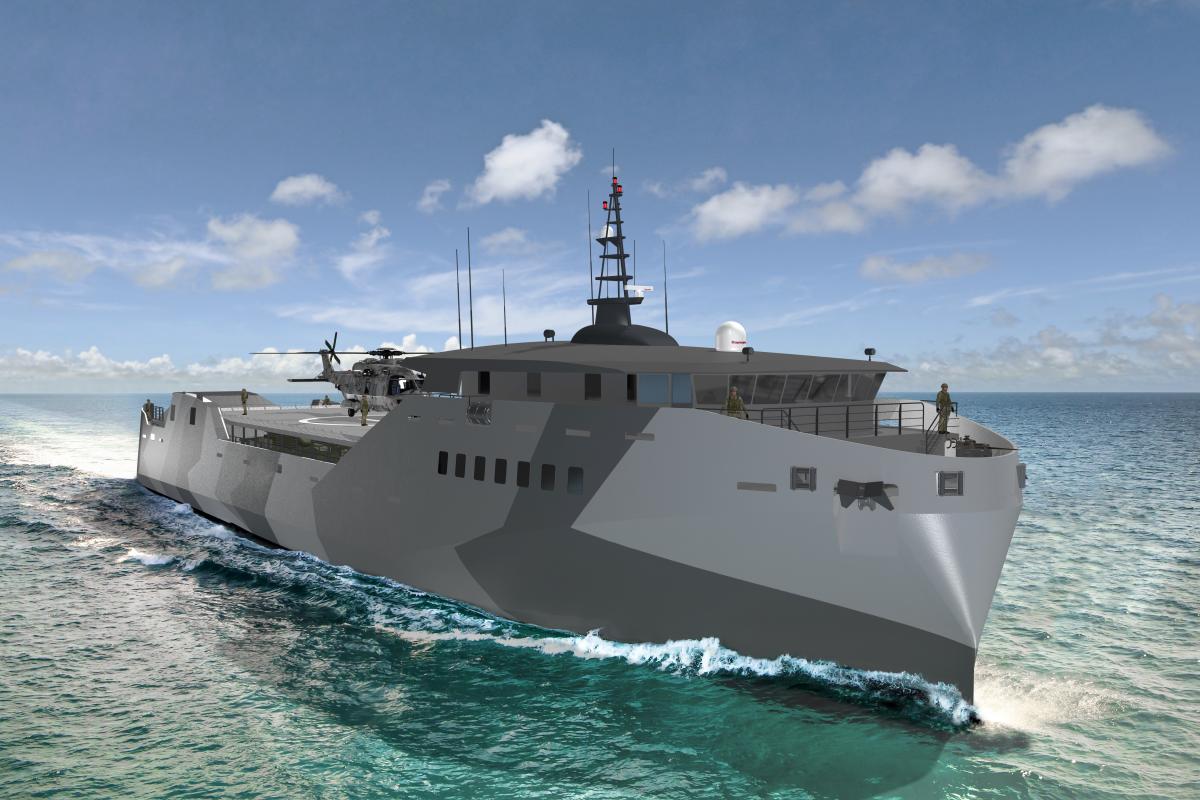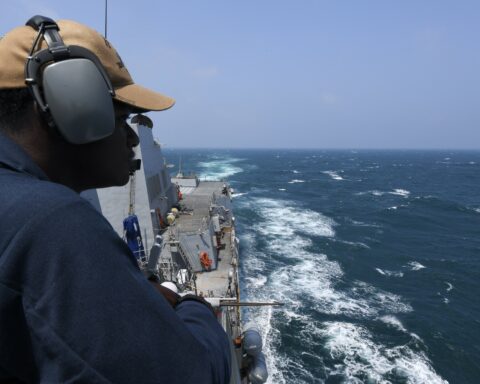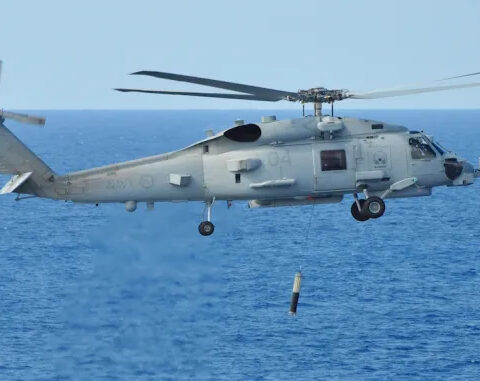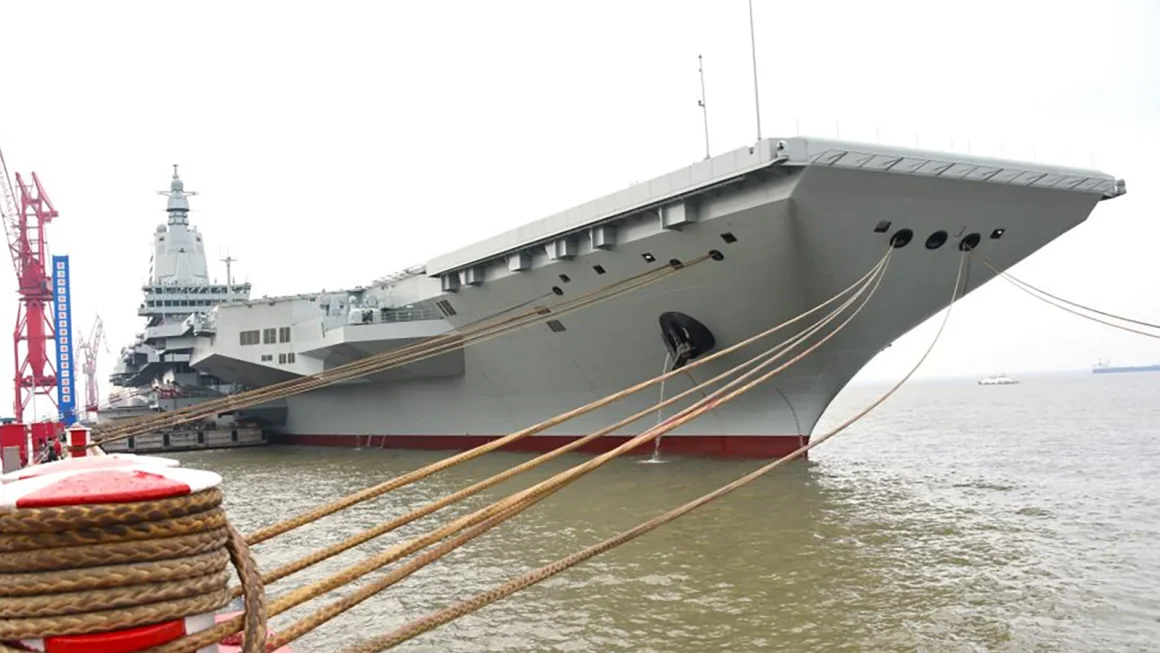
After making a series of modifications to an offshore support vessel, the Marine Corps Warfighting Lab is ready to start experimenting with a prototype for a landing ship the Marines say is key to the service’s island-hopping future in the Western Pacific.
Through Military Sealift Command, the Marine Corps has contracted Hornbeck Offshore Services to alter the offshore support vessel for the types of missions it envisions Marines taking on in future conflict. The service took the existing vessel and added the capability to land Marines and equipment from the stern.
“We’ve added a large ramp to the vessel to make it more beachable. The company has added a bunch of landing skegs and other protective things in the rear underpart of the ship to protect the rudders and the props, again, because we are looking to beach this vessel at the stern,” Lt. Col. Timothy Smith, the Marine Corps Warfighting Lab’s logistics combat element lead, told reporters today.
“The vessel has a 12-foot draft. It’s got 6,000 square feet of cargo space on a wet deck. It has the capability to hold 38 Marines and a commercial crew of somewhere between 12 to 15 mariners.”
Smith said the service does want the ship to eventually carry more Marines. Officials acknowledged that the goal is for the LSM to carry 75 Marines, but said this initial experimentation effort is what the service could move out on first.
“The LSM objective was and is 75 Marines and the [stern landing vessel] is helping articulate the need for that. In the future, we can take a look at is that 75 still necessary? We think it is, but the SLV will help flesh that out,” said Maj. Samuel Modica, the capabilities integration officer for maritime expeditionary warfare at the Marine Corps Combat Development and Integration.
The modifications also included adding a galley and a place for Marines for mission planning, while they can live in a modular container aboard the ship.

“It also has some landing legs that we’ve added for stability to learn how stern landing vessels actually work in the surf conditions. We’ve reinforced the deck of the vessel so it can carry everything in the Marine Corps inventory right now, up to a ratch with a loaded 40-foot container. I don’t think we’ll be doing that in the future but we wanted to make sure that the service had the capability to experiment with and if that was a requirement, be able to do so,” Smith said.
The stern landing vessel is meant to help the Marine Corps figure out how it will use landing ship medium – the new name for what was previously known as the Light Amphibious Warship – to shuttle Marines between islands and shorelines in the Indo-Pacific.
Smith said the modified OSV can carry both normal and aviation gasoline and that it will help eventually assist the Marine Corps with work on unmanned aerial vehicles and Amphibious Combat Vehicles.
MCWL will get the first leased ship in March and is working with industry on the options to lease two more, which it expects to get in 2024. The service is going through industry for the second and third vessel, so Hornbeck Offshore Services may or may not make the modifications.
The goal is for MCWL’s experimentation to inform the requirements for landing ship medium. During a Monday call with reporters, Smith described four phases of experimentation.
“We’re going to find out how does the SLV actually work in some benign conditions, with the graduation exercise obviously going to locating surf in the ocean, how does it actually work, do we have to use the jacking legs? What’s the impact to the beaches that we’re working? What is the impact of the ramp? Does it really do everything it says it’s going to do?” he said of the first phase.
The second phase includes figuring out how the Marine Corps can onload and offload its vehicle inventory using the stern landing vessel and editing manuals on how to use the platforms.
“Once we deem that the vessel is safe to operate, right, it will then transition or transfer within MCWL over to the experiments division and we will start doing some limited things with the fleet,” he said.
After the initial experimentation at MCWL, the SLV will head to California and then probably to Hawaii for more testing, Smith said.
“Following that, it’s going to definitely be heavy in future MLR experimentation, different mobility and logistic assessments. And we’re going to develop and refine a lot of concepts of employments, tactics, techniques and procedures,” Smith said.
Phase three is figuring out how the platform will operate in the fleet, while phase four will scale that up from the fleet to the joint force to determine how the platform can also work with the Army and Air Force.
The stern landing vessel will allow the Marine Corps to experiment now, as it finishes requirements for landing ship medium.
“The sole purpose of these vessels that we are … leasing … is to support what we refer to as live force experimentation,” said Jeff Tomczak, MCWL’s deputy director for science and technology.
“Because the ships themselves are fairly mature, when you look at them as a technology, fairly mature, they are out there performing real-world missions as part of the experimentation so that we can get exposure with the operational forces – the stand-in-forces – they can get the necessary exposure with the vehicle while they’re participating in real-world exercises so we can get the necessary feedback to define what the requirement looks like to inform those people that are going to be procuring the landing ship mediums in the future.”





